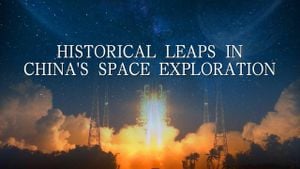Humanity's interest in space exploration is reigniting, fueled by advancements in technology and international partnerships aiming for longer lunar missions and eventual Mars expeditions. A prime example is the development of the Lunar Terrain Vehicle (LTV), part of NASA's Artemis program. This initiative emphasizes not only lunar exploration but also the ambition to establish sustained human presence beyond Earth. Central to this mission is Fugro, known for its prowess in robotics, which is assisting Intuitive Machines with the creation of the Moon RACER LTV.
The LTV stands out as it’s built for both autonomous and human operations, featuring advanced navigation, communication systems, and power management capabilities. Designed to transport cargo and conduct scientific experiments, the vehicle will play a pivotal role in future exploratory missions. Sam Forbes, Director of Fugro SpAARC, expressed pride in their contribution, stating, "We are proud to partner with Intuitive Machines on the Lunar Terrain Vehicle as part of NASA's Artemis campaign. This partnership marks our commitment and expertise supporting lunar surface operations tightly aligned with the mission's objectives."
Meanwhile, NASA's Artemis program plans to leverage existing rover technologies to create commercial vehicles capable of long-term lunar operations, potentially setting the stage for Mars missions. The commitment to developing commercial rover capabilities signals the importance of partnerships between governmental and commercial entities to advance scientific research and practical exploration.
Further support for lunar exploration technology is found within FASTNAV's latest initiatives. Faced with the demand for faster navigation and dynamic control, the FASTNAV project has developed technology allowing rovers to exceed speeds of 1 m/s – far faster than traditional lunar navigation methods. By integrating sophisticated computer vision and artificial intelligence, these rovers can independently navigate challenging terrains and efficiently respond to obstacles without halting. Steven Kay, GMV's UK Robotics lead, remarked, "The advancements made in this project open opportunities not just for space exploration but also relevant applications within industries like mining and humanitarian operations."
The innovative performance of these projects highlights humanity's drive for exploration. This rebirth of exploration not only aims for the Moon but extends to Mars, with companies like SpaceX mobilizing through their partnerships and technology developments.
Just last July, Arianespace successfully launched the Ariane 6 rocket, marking Europe’s significant foray back to commercial spaceflight. With complete analysis confirming strong performance and necessary software updates, Arianespace has already undertaken preparations for its next launches scheduled for mid-February 2025. CEO Stephane Israel expressed enthusiasm for this initiative, emphasizing support from various stakeholders, including the French Ministry for the Armed Forces.
Martin Sion, CEO of ArianeGroup, noted the importance of the data retrieved from the initial flight, stating, "Careful analysis enabled us to make necessary adjustments for Ariane 6's future missions and confirm its capabilities as Europe’s heavy-lift launcher aimed at fulfilling all mission requirements." With continued investments and support from the European Space Agency, the future looks bright for Europe’s role in space.
Beyond the rocket launches and lunar rover developments, Earth observation technologies are also advancing. China’s recent introduction of the PIESAT-2 satellites enhances the country's capability to gather and analyze Earth data, playing a role across various domains, such as urban planning and environmental monitoring. By utilizing interferometric synthetic aperture radar (I-SAR), these advancements allow for high-precision mapping and ground movement detection. The successful deployment of PIESAT-1 earlier this year laid the groundwork for this innovative approach.
This integrated advancement approach reinforces the reality of modern space exploration – collaboration and cross-emission technology applications are now more important than ever. With increasing projects focused on observational technologies and the growing sophistication of robotic missions, the global stage for exploration is becoming as interconnected as it is competitive.
Even as projects advance, systems like NASA’s International Space Station (ISS) maintain their central role for research and development. The ISS has served as humanity's laboratory above Earth, facilitating research necessary for future long-term space travel and paving the way for deep space missions. With resupply missions and cargo deliveries led by SpaceX, the project continues to evolve as NASA sets its sight on sustainable operations within low Earth orbit.
These ventures represent significant milestones as humanity not only strives to return to the Moon but also aims for Mars and beyond. Rigorous testing, technological advancements, and collaborative efforts create the foundations necessary for extended human presence off-planet; our aspirations for exploration and scientific discovery are as ambitious as they are achievable.
The loading of knowledge and technology reflects not just on exploration but on the need for sustainability, collaboration, and innovation. The future of space exploration hinges on humanity's ability to leverage interconnected systems – whether operating satellites from Earth, coordinating lunar missions, or executing resupply runs to space stations. The synergy between these efforts clarifies one thing: we are only at the beginning of what our capabilities can achieve beyond our local sphere.
Space exploration is poised for continued advancements and discoveries, driven by innovation and shared knowledge among nations and corporate entities. The merging of space technologies, including transport vehicles like the LTV, Ariane 6, and various satellite systems, signifies the commitment to maintaining humanity's connection to our celestial ambitions.



